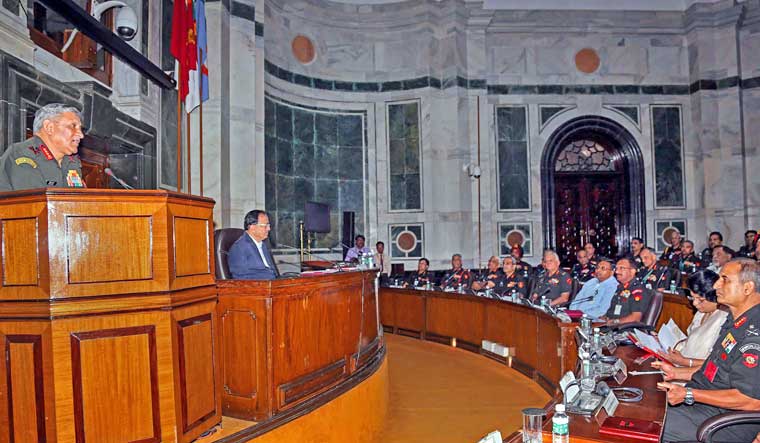The issue of radicalisation of Kashmiri youth was figured prominently in the bi-annual meet of the top military commanders, while discussing ways to minimise the 'collateral damage' during operations against militants.
There has been a sharp increase in young Kashmiris joining militant groups in the recent past, in 2017, 126 young boys from Kashmir valley have joined militant ranks. Numbers took sharp spike, after the killing of self-styled commander of Hizbul Mujahideen, Burhan Wani by the security forces. In the last three years, a total of 280 youths from Kashmir have reportedly joined terror groups.
"It was felt that priority must be accorded towards ushering peace by conducting counter-terrorist operations that minimise collateral damage. Radicalised youth must be brought into the mainstream by carrying out de-radicalisation and collective approach that focuses on convincing the youth to shun violence and gun culture," Director General Staff Duties Lt. Gen. A.K. Sharma, who has earlier headed Nagrota (Jammu) based 16 Corps said, while sharing details on the discussions during week long Army Commanders Conference in New Delhi.
Army maintained that the there is a need for the political leadership and civil society to come forward and suggest ways to contain the propaganda by terror outfits, especially on social media, to influence Kashmiri youth.
Army chief General Bipin Rawat also spoke on the issue of radicalisation of youth and blamed the social media for the radicalisation of people, particularly the youth in the state and said that army is taking the issue with “lot of seriousness”.
While referring to the recent incidents of stone pelting by the local residents at security forces, during an encounter so as to facilitate escape of the militants, the Army commanders pressed for a review of their counter-terrorism operations strategy.
"The apex commanders confabulated on the prevalent situation in the Valley and reviewed the recent developments affecting the modus operandi of operations of the armed forces deployed in the region," Lt. Gen Sharma added.
Till date, security forces have gunned down 51 militants in the Kashmir valley in operations carried out on the Line of Control or in the hinterland this year. Simultaneously, we have lost 26 of our soldiers in such operations. Last year, 13 soldiers were martyred during counter-terrorism operations in Kashmir valley.
Top military commanders also discussed the prevailing situation along the northern border with China and Pakistan, particularly "along the Line of Control, the increase in ceasefire violations and the adequacy of the response mechanisms”. Top army brass also talked about the "capacity building endeavours including, infrastructural development and measures to provide them requisite impetus" on the northern border.
So far, this year, there have been around 700 incidents of ceasefire violations by the Pakistan army on the border, while the figure was 800 incidents of ceasefire violations in the last complete year.
Army's top brass also deliberated at other key issues including financial management, equipment optimisation, management of communication and data security and streamlining of existing procedures pertaining to administration. Discussions were also held on cyber security and security of military establishment and bases.
"Considerable time was spent on re-prioritising the existing requirements to ensure that resources allocated for force modernisation and capacity building were utilised optimally within the budgetary allocation. The discussion also dwelt upon increasing the content of indgenisation in force modernisation," General Sharma further said.
India is spending only 1.57 per cent of its Gross Domestic Product (GDP) for the year 2018-19 on the defence sector, the lowest since the 1962 war with China. And for re-equipping armed forces, defence ministry has received Rs 2.95 lakh crore in comparison to Rs 2.74 lakh crore last year. With a heavy baggage of liabilities of the previous years, there will hardly be any money left for new purchases.
Like for instance,the capital budget for the Army, has only gone upto Rs. 26688 crore from Rs. 25175 crores last year. At a time when, military experts argue to enhance our capabilities on northern sector, money allocated for tanks and armoured vehicles have seen a major cut from last year. Last year, Rs 3193 crore was allocated for tanks and armoured vehicles, army has got only Rs 1972 crore in this year's budget. Army has to be blamed for this, as it failed to utilise the allocated money in this category and returned nearly Rs 1200 crore to the national exchequer. Similarly, the money allocated for artillery guns, was increased only to Rs 17197 crore this year from Rs 15112 crore in last year.


